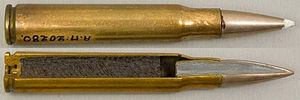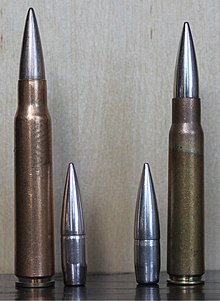| 8×63mm | ||||||||
|---|---|---|---|---|---|---|---|---|
 Two 8×63mm patron m/32 military cartridges Two 8×63mm patron m/32 military cartridges | ||||||||
| Type | Rifle | |||||||
| Place of origin | Sweden | |||||||
| Service history | ||||||||
| In service | 1932–1975 | |||||||
| Used by | Sweden | |||||||
| Wars | UN intervention in Kongo 1960-1964 | |||||||
| Production history | ||||||||
| Designer | Kungliga Armétygförvaltningen (KAF) AktieBolaget Bofors | |||||||
| Designed | 1927–1932 | |||||||
| Manufacturer | AB Bofors | |||||||
| Specifications | ||||||||
| Case type | Rebated, bottleneck | |||||||
| Bullet diameter | 8.20 mm (0.323 in) | |||||||
| Neck diameter | 9.10 mm (0.358 in) | |||||||
| Shoulder diameter | 11.51 mm (0.453 in) | |||||||
| Base diameter | 12.43 mm (0.489 in) | |||||||
| Rim diameter | 12.18 mm (0.480 in) | |||||||
| Rim thickness | 1.42 mm (0.056 in) | |||||||
| Case length | 62.81 mm (2.473 in) | |||||||
| Overall length | 84.62 mm (3.331 in) | |||||||
| Primer type | Berdan, Large rifle | |||||||
| Ballistic performance | ||||||||
| ||||||||
| Test barrel length: 609 mm (24 in) Source(s): | ||||||||
The 8×63mm patron m/32 was a bottlenecked centrefire cartridge with a slightly (0.25 mm (0.0098 in)) rebated rim for Swedish heavy and medium machine guns. It was used from 1932 to the finalisation of the re-chambering process of these machine guns to 7.62×51mm NATO in 1975.
History

Right; 7.92×57mm Mauser cartridge
and 11.55 g (178.2 gr) S.m.E. (mild steel cored) 8 mm S bore bullet
Given the experiences of the devastating effect of small arms fire, including the long-range, even indirect fire of the machine guns, in the Russo-Japanese War and World War I, as well as a revolution in terminal ballistic calculations, calibre-related concerns occupied a lot of attention worldwide in military establishments. Sweden was no exception, and series of trials in calibres 6mm-12mm were conducted until the late 1920s. At this time, the standard service cartridge in Swedish use was the 6.5×55mm Swedish skarp patron m/94 projektil m/94 (live cartridge m/94 projectile m/94) service ammunition loaded with a 10.1 grams (156 gr) long round-nosed m/94 (B-projectile) bullet. After study-travels by Lieutenant Colonel de Laval along with Captains Nygren and Holmgren, mainly to Germany and the Netherlands in October 1930, Royal Swedish Army Materiel Administration (Kungliga Armétygförvaltningen (KAF) appointed a commission that conducted a series of tests with calibres 6,5 mm to 7,2 – 7,5 – 7,9 mm, and bullet weights between 8.4 grams and 17.0 grams, with the intention to either recommend a new calibre for the kulspruta m14-29 or retain the 6.5×55mm but with a new boat tailed spitzer bullet, as the old blunt nosed projectile m/94 had inferior ballistics. The commission found that at ranges below 2,400 m (2,625 yd), no recommendation could be given without indepth analysis of intended tasks within the tactical doctrine. Past this, the 14.2 gram bullet in calibre 7.9mm had superior performance in precision and penetration while not causing excessive barrel wear as well as fulfilling the requirement of 20 kilogram-metres impact force up to a range of 3,600 m (3,937 yd). Based on this, KAF tasked AB Bofors to develop and manufacture the larger rifle cartridge to meet these needs.
Design
The patron m/32 round had the same overall length as the .30-06 Springfield cartridge, which allowed it to fit in the standard Browning receiver, but used a larger diameter case and share the 6.5×55mm 12.2 mm (0.48 in) diameter bolt face. Compared to the 1928 pattern .30-06 Springfield M1 Ball the 8×63mm patron m/32 was loaded with 8.20 mm (0.323 in) S bore 14.2 g (219.1 gr) bullets and had more muzzle energy. The 8×63mm patron m/32 had a muzzle velocity of 760 m/s (2,493 ft/s) and an operating pressure of 330 MPa (47,862 psi).
The patron m/32's aerodynamically refined boat tailed spitzer bullet had a useful range of approximately 3,600 m (3,937 yd) on which the impact energy was 20 kilogram-meters (196 J / 145 ft⋅lbf), and a maximum range of approximately 5,500 m (6,015 yd) when fired from a kulspruta m/36. Reverse engineering the trajectory from the previous sentence indicates a ballistic coefficient (G1 BC) of approximately 0.63. Available with armour piercing bullets, patron m/32 was used in the UN-forces' KP-bil during the Congo-crisis against the separatists' armoured cars.
The 8×63mm patron m/32 cartridge was used in the following machine guns:
The 8×63mm patron m/32 was also used in the gevär / pansarvärnsgevär m/40 bolt-action rifle, Karabiner 98k's re-chambered in Sweden for the patron m/32. Originally purchased as the pvg m/39 in 8×57 IS as a stop-gap anti-tank rifle (despite being unsuited for the role), the re-chambered 8×63 rifles were designated m/40, and later issued to machine gun crews so their rifles would fire the same round as their machine guns. Besides the rechambering a muzzle brake was added necessitated by the additional recoil produced by the more powerful 8×63mm patron m/32 cartridge.
Military ammunition
| Designation | Type | Weights (gram) | Propellant type | Projectile material(s) | Muzzle velocity V0 or V25 | Burning range | Marking | Remarks | ||
|---|---|---|---|---|---|---|---|---|---|---|
| Cartridge | Projectile | Propellant | ||||||||
| 8 mm sk ptr m/32 | FMJ | 32.1 g (495 gr) |
14.13 g (218.1 gr) |
3.6 g (56 gr) |
Kspkr 1/0,55 | Lead core, Nickel jacket | 750 m/s (V25) | None | Standard Ball. | |
| 8 mm sk ptr m/32
"For peacetime only" |
FMJ | 32,17 | 14,2 | 3,6 | Kspkr 1/0,55 | Lead core, Nickel jacket | 760 m/s (2,500 ft/s) |
Blue tip | Ammunition of inferior quality.
Used in peacetime. | |
| 8 mm sk ptr m/32
"Not for machine guns" |
FMJ | 32,17 | 14,2 | 3,6 | Kspkr 1/0,55 | Lead core, Nickel jacket | 760 m/s | Green tip | Same as above but has green marking.
This means "Not for machine guns" | |
| 8 mm sk ptr m/32 pprj m/39 | AP | 29,7 | 11,8 | 3,6 | Kspkr 1/0,55 pbr | 3,2 g steel core | 780-810 m/s | Black tip | Ordinary armor-piercing cartridge. Penetration of ~10 mm at 50 m | |
| 8 mm sk ptr m/32 pprj m/40
or 8 mm pbr ptr m/32-40 |
AP | 31,14 | 15,7 | 3,6 | Kspkr 1/0,55 pbr | Tungsten core | 725 m/s | Top half black | Tungsten-cored ammunition. Penetration of ~20 mm at 0 m
Only used in machine guns. | |
| 8 mm sk ptr m/32 slprj m/39 | Tracer | 28,9 | 11,01 | 3,6 | Kspkr 1/0,55 | Projectile contains phosphorus, no boat tail | 780-824 m/s | red 100-800 m | Red tip | First marking of slprj m/39 |
| White tip | Second marking of slprj m/39. | |||||||||
| 8 mm sk ptr m/32 slprj m/39
"with a different primer" |
Tracer | 28,9 | 11,01 | 3,6 | Kspkr 1/0,55 | Projectile contains phosphorus, no boat tail | 780-824 m/s | Red 100-800 m | Red tip | The primer is dark gray and non-magnetic. Likely manufactured in Germany. |
| 8 mm sk ptr m/32 brandprj m/40 | Incendiary | 11,55 | Phosphorus and lead | Yellow tip | Incendiary ammunition from Hungary. Trubbkula. | |||||
| 8 mm sk ptr m/32 brandprj m/41 | Incendiary/AP | 27,7 | 9,8-9.9 | 3,6 | Kspkr 1/0,55 pbr | Has an internal steel core surrounderd by fuel | 835-930 m/s | Orange tip | The ammunition is primarily for aircraft and is a semi-armor piercing projectile | |
| 8 mm Tysk B patron
"Observation cartridge" |
High-explosive incendiary | Bottom halve black | German B bullet loaded in a Swedish 8×63 cartridge. | |||||||
| 8 mm sk blindptr m/32 | Dummy | None | Early marking. | |||||||
| 8 mm sk blindptr m/32 | Dummy | Green tip | Late marking. | |||||||
The operating pressures of the various ammunition types varied between 330–350 MPa (47,862–50,763 psi).
See also
References
- 8x63 Swedish / 8x63 Bofors (in Russian)
- ^ Sammanfattning av rapport Till Kungl. Arméförvaltningens artilleridepartement (in Swedish)
- The useful maximum range is defined by the maximum range of a small-arms projectile while still maintaining the minimum kinetic energy required to put unprotected personnel out of action, which is generally believed to be 15 kilogram-meters (147 J / 108 ft⋅lbf).
- Kjellgren, G. L. M. "The Practical Range of Small Arms" (PDF). The American Rifleman. pp. 40–44. Archived (PDF) from the original on 5 March 2015.
- Swedish Kulspruta m/36 at forgottenweapons.com
- Arméplanch för utbildning fotograferad av Göta Vapenhistoriska Sällskap (in Swedish)
External links
- 8x63 M32 Bofors
- HISTORIC MACHINE GUN CARTRIDGES by Anthony G Williams Archived 2022-03-03 at the Wayback Machine
- 8x63 Swedish / 8x63 Bofors (in Russian)
- 8x63 Swedish Bofors / 8 mm Bofors / 8x63 Swedish For MG Mod.1932 / 8mm SK PTR M-32 / 8mm Sueco / 8x63 / SAA 4540 / XCR 08 063 BGC 010 (In Spanish)
- The Swedish military ammunition site
- Ammunitionsregister för armén, 1960
- instruction drawings of 8×63mm patron m/32 ammunition
- Military Small Arms Ammunition of the World, 1945-1980, P. Labbett
| Rebated rim (RB) cartridges | |
|---|---|
| Pistol / carbine / PDW | .41 AE • .429 DE • .440 Cor-Bon • .475 Wildey Magnum • .50 AE • .50 GI • FN 5.7×28mm • HK 4.6×30mm |
| Rifle (intermediate & fully powered) | .276 Enfield • .284 Winchester • .30 Remington AR • .350 Legend • .375 SOCOM • .375 Swiss P • .400 Legend • .416 Hushpuppy • .425 Westley Richards • .45 Raptor • .450 Bushmaster • .458 HAM'R • .458 SOCOM • .45-70 Auto • .499 Leitner-Wise • .50 Beowulf • .50 Krater • .500 Jeffery • .502 Thunder Sabre • .505/.404 Stewart • .510 Beck • .585 Nyati • .600 Overkill • 6.5-284 Norma • 6.8 Western • 8×63mm patron m/32 • 8×68mm S • Nosler cartridges (22 • 26 • 27 • 28 • 30 • 33) • Remington Short Action Ultra Magnum (7mm • .300) • Remington Ultra Magnum (7mm • .300 • .338 • .375) • Winchester Short Magnum (.270 • 7mm • .300 • .325) • Winchester Super Short Magnum (.223 • .243 • .25) |
| Autocannon (20mm+) | 20×70mmRB • 20×72mmRB • 20×80mmRB • 20×101mmRB • 20×110mmRB • 20×128mmRB • 30×90mmRB • 30×92mmRB • 55×175mmRB |